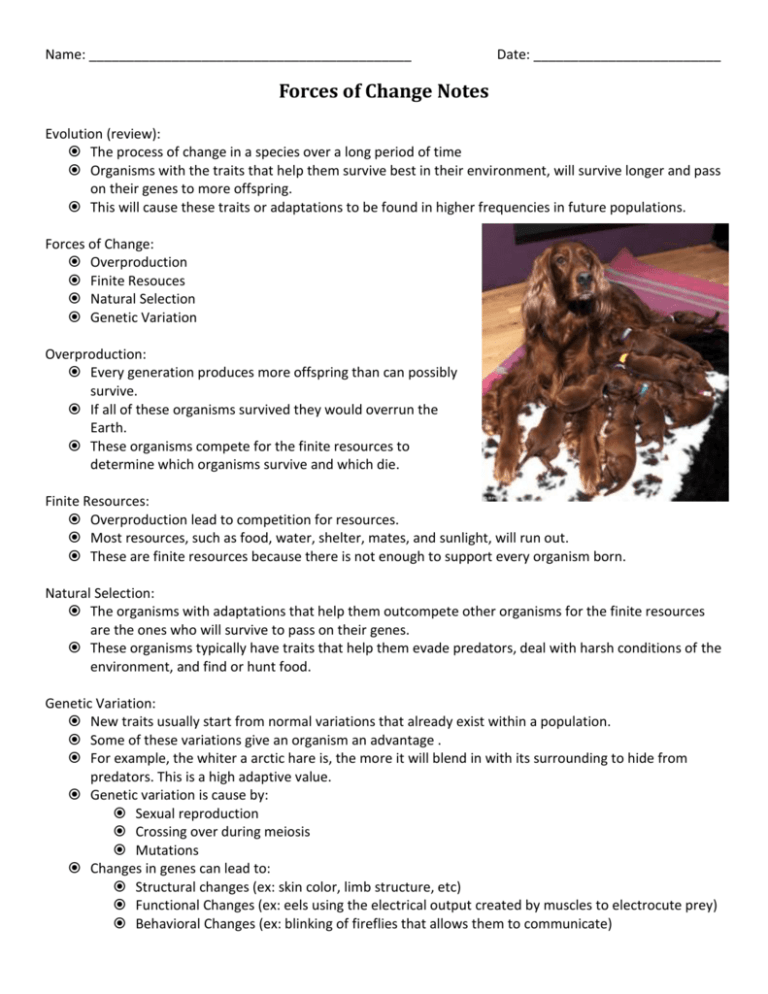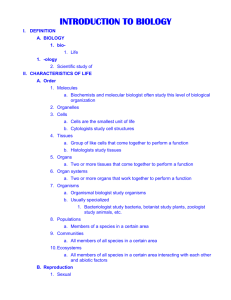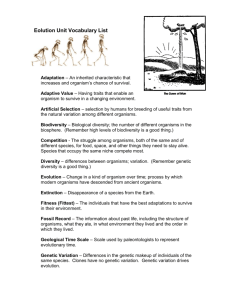Name: Date: Forces of Change Notes Evolution (review): The
advertisement

Name: ___________________________________________ Date: _________________________ Forces of Change Notes Evolution (review): The process of change in a species over a long period of time Organisms with the traits that help them survive best in their environment, will survive longer and pass on their genes to more offspring. This will cause these traits or adaptations to be found in higher frequencies in future populations. Forces of Change: Overproduction Finite Resouces Natural Selection Genetic Variation Overproduction: Every generation produces more offspring than can possibly survive. If all of these organisms survived they would overrun the Earth. These organisms compete for the finite resources to determine which organisms survive and which die. Finite Resources: Overproduction lead to competition for resources. Most resources, such as food, water, shelter, mates, and sunlight, will run out. These are finite resources because there is not enough to support every organism born. Natural Selection: The organisms with adaptations that help them outcompete other organisms for the finite resources are the ones who will survive to pass on their genes. These organisms typically have traits that help them evade predators, deal with harsh conditions of the environment, and find or hunt food. Genetic Variation: New traits usually start from normal variations that already exist within a population. Some of these variations give an organism an advantage . For example, the whiter a arctic hare is, the more it will blend in with its surrounding to hide from predators. This is a high adaptive value. Genetic variation is cause by: Sexual reproduction Crossing over during meiosis Mutations Changes in genes can lead to: Structural changes (ex: skin color, limb structure, etc) Functional Changes (ex: eels using the electrical output created by muscles to electrocute prey) Behavioral Changes (ex: blinking of fireflies that allows them to communicate) Biodiversity: Variation in a population is important because the environment changes. If all organisms of a species were exactly the same, a small environmental change could wipe out an entire species. Once diversity is lost it is nearly impossible to get back. That is why scientists try to protect endangered species. Patterns of Change: Changes in a species is often related to environmental changes › So, a rapidly changing environment will lead evolution to occur more rapidly. Species with short reproductive cycles producing more offspring tend to evolve more quickly. Failure to adapt to a change in the environment may lead to extinction. Extinction: The disappearance of an entire species. Extinction is possible when the death rate is higher than the birth rate. Extinction is usually caused by big environmental changes Sometimes these big environmental changes are the fault of humans. Phylogenetic Trees: Phylogenetic trees show us when a species divided to become two separate species. We can also see which species were poorly adapted and became extinct. We can determine which organisms are most closely related, by looking at which organisms have the most recent common ancestor. Name: ___________________________________________ Date: _________________________ Forces of Change Notes Evolution (review): The process of change in a ____________ over a ____________ period of time Organisms with the traits that help them ________________ best in their environment, will survive longer and pass on their _____________ to more __________________ This will cause these traits or __________________ to be found in _______________ frequencies in future populations. Forces of Change: Overproduction Finite Resouces Natural Selection Genetic Variation Overproduction: Every generation produces ____________ offspring than can possibly ________________ If all of these organisms survived they would overrun the Earth. These organisms ________________ for the finite ________________ to determine which organisms _______________ and which die. Finite Resources: Overproduction lead to competition for resources. Most resources, such as ___________, water, shelter, ____________, and sunlight, will run out. These are _______________ resources because there is ________ enough to _______________ every organism born. Natural Selection: The organisms with _______________________ that help them ___________________ other organisms for the finite resources are the ones who will survive to pass on their genes. These organisms typically have traits that help them _____________ predators, deal with harsh conditions of the __________________, and find or hunt ______________ Genetic Variation: ___________ traits usually start from __________________ variations that already exist within a population. Some of these variations give an organism an __________________ For example, the whiter an arctic hare is, the more it will ____________ in with its surrounding to hide from predators. This is a __________ adaptive ___________ Genetic variation is cause by: ______________ reproduction Crossing over during ______________ ____________________ Changes in genes can lead to: Structural changes (ex: skin color, limb structure, etc) Functional Changes (ex: eels using the electrical output created by muscles to electrocute prey) Behavioral Changes (ex: blinking of fireflies that allows them to communicate) Biodiversity: Variation in a population is important because the environment _______________ If all organisms of a species were exactly the ____________, a small environmental change could wipe out an _____________ species. Once diversity is ____________ it is nearly __________________ to get back. That is why scientists try to protect ______________________ species. Patterns of Change: Changes in a _______________ is often related to ____________________ changes › So, a rapidly _______________ environment will lead _________________ to occur more __________________ Species with short ___________________ cycles producing ____________ offspring tend to evolve more __________________ _______________ to adapt to a change in the environment may lead to ___________________ Extinction: The _________________________ of an entire species. Extinction is possible when the _______________ rate is ____________________ than the __________ rate. Extinction is usually caused by __________ environmental changes Sometimes these big environmental changes are the fault of __________________ Phylogenetic Trees: Phylogenetic trees show us when a species ________________ to become two separate species. We can also see which species were _________________ adapted and became _________________ We can determine which organisms are most closely _________________, by looking at which organisms have the most ___________________ common ancestor. Classification Notes 1: What everyday things do we categorize into groups? 2: How do we determine these groups? Classification - ________________________________________________________________ Must be ___________________ and ________________ to understand. Must be ___________________ (the same) at different times in different ____________. Taxonomy - __________________________________________________________________ _____________________________________________________________________________ History of Classification: Aristotle Created two kingdoms: ______________ and ______________________ Grouped animals based on where they ________________: creatures of the __________, _______________, and _________________. Too many animals did not fit into those categories. (Ex:_____________________) Linnaeus Created a system of classifying animals based on their ______________________ These similarities included _____________ structure, body __________________, shape, color, and means of obtaining ________________. Modern Classification Looks at the traits ___________________ used (ex: size and body ___________) and also traits that are not so easy to observe (ex: ____________________ in the body and ____________) Our modern classification system has ________________ levels. K_________________ Phylum King P________________ C______________ Came Order O_______________ F______________ Genus S________________ For G_____________ Spaghetti Phylogeny: Since ________________ came up with the theory of common descent, we have been trying to make ___________________________ between species and figure out how the ____________________ of life progressed We use _________________ to show these connections Any _________________ point on a tree indicates when a common _________________ changed to become ___________ or more separate _______________ The organisms that share a more _________________ common ancestor are more closely ________________ Phylogenetic Trees: Uses __________ or __________ questions to create groups. Gives a visual of the ____________________. Dichotomous Key: An ______________________ way for other scientists to find out which group(s) and new ____________________ might belong to. Puts the ____________ into chart form. Questions: 1: What is a Dichotomous (Die-cot-o-mus) Key used for? 2: Who was the first to start to categorize animals? 3: What are Phylogenetic trees and what do they show us? 4: What does it mean for something to go extinct? 5: What does finite resource mean? 6: What is Biodiversity and why is it important? 7: Why is Genetic Variation important for survival? 8: What is Natural Selection? 9: What is Evolution and what causes it to happen?








